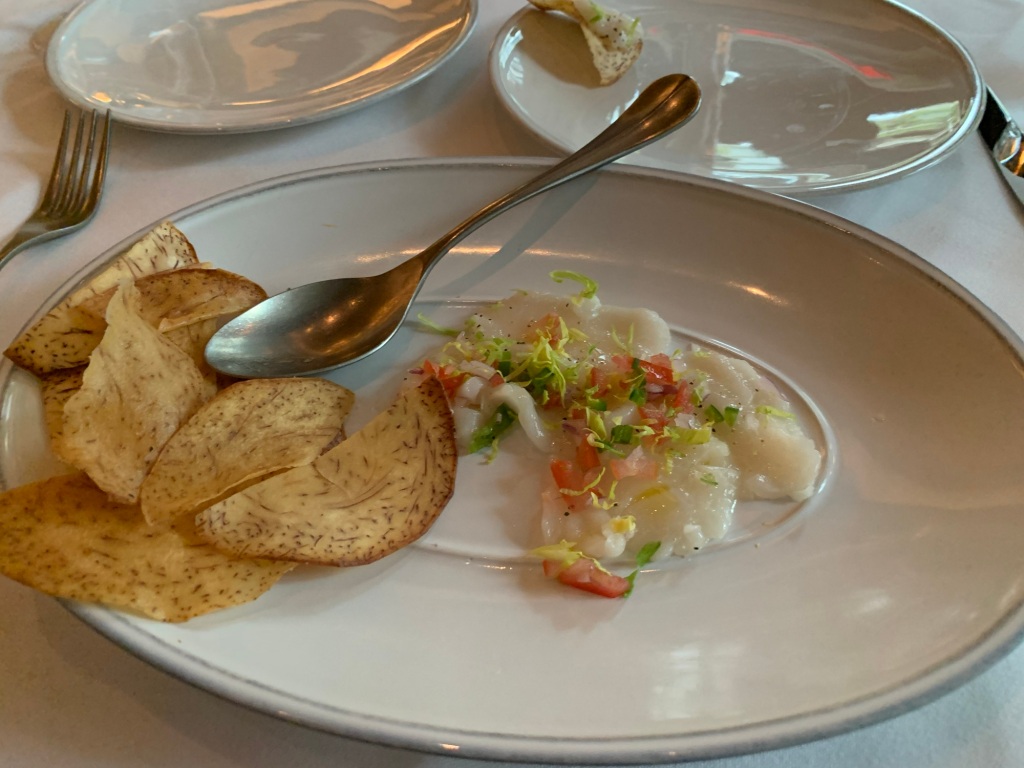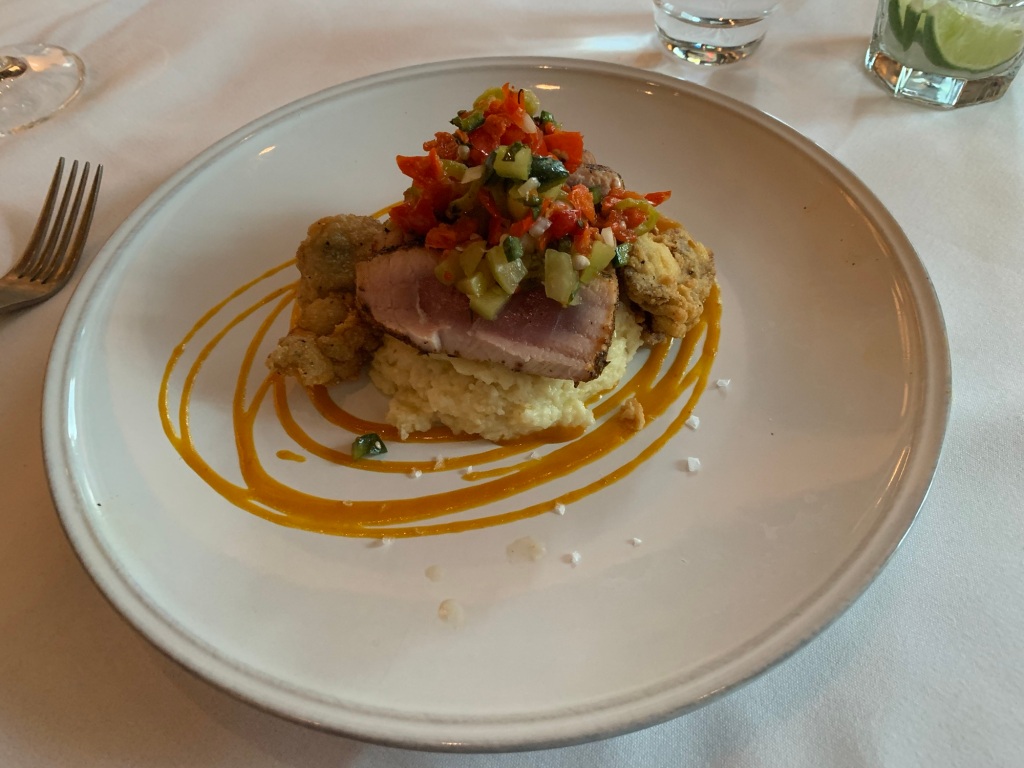
There’s been a lot of buzz about Hank’s, the new restaurant opening at the corner of Gay and High Streets in downtown Columbus. Last night we checked out Hank’s on its official opening night, and I can comfortably say that the buzz is warranted.
Hank’s is a seafood and low country cuisine venue that comes to Columbus from Charleston, South Carolina, where it is one of the finest culinary establishments in that food-loving town. Its arrival is welcome, because our downtown area is noticeably lacking in seafood options. Steakhouses we’ve got, but seafood? Not so much. Hank’s aims to change that.
The restaurant has a casual elegant vibe, with a wraparound bar and oyster bar, leather seats, and white-jacketed waiters. And the food fits in well with the casual elegant atmosphere. At the recommendation of the friendly bartender, we got the scallops crudo appetizer, pictured above. It featured thinly sliced, succulent scallops that you spooned onto crisps. It was, in a word, delicious. Kish got the she crab soup, which also was terrific. It came in a huge bowl, too—big enough for two, which made me happy since I wrestled it away from her so I could enjoy a few spoonfuls of rich she crab goodness.
The bartender also recommended the ahi tuna entree, shown below—and she therefore went 2 for 2. it featured slices of rare, blackened sushi grade tuna served over cheesy grits, with two fried oysters as a complement. After I scraped off the diced vegetables on top (sorry, Hank’s!) I enjoyed the combination of low country flavors and textures in every bite. I second the barkeep in highly recommending this dish.
My doctor is always encouraging me to eat more fish. Thanks to Hank’s, that challenge just got a lot easier. I’m looking forward to the day, coming soon, when Hank’s opens for lunch.






 The Hunley was supposed to be one of the Confederacy’s secret weapons, and a way to break the strangling blockade Union warships placed around Confederate ports. It was a 42-foot-long, cast iron cylinder that was powered by a hand-cranked propeller. Built in Mobile, Alabama in 1863, it was transported to Charleston, South Carolina, where it was supposed to move underwater and attach explosive torpedos to the hulls of Union ships.
The Hunley was supposed to be one of the Confederacy’s secret weapons, and a way to break the strangling blockade Union warships placed around Confederate ports. It was a 42-foot-long, cast iron cylinder that was powered by a hand-cranked propeller. Built in Mobile, Alabama in 1863, it was transported to Charleston, South Carolina, where it was supposed to move underwater and attach explosive torpedos to the hulls of Union ships. Fort Sumter, located in the harbor of Charleston, South Carolina — the epicenter of the rebellion — became one of Lincoln’s first challenges. The day after his inauguration, Lincoln received a message from Major Robert Anderson, the commander of the fort’s garrison of less than 100 men, announcing that Fort Sumter was equipped with only six weeks’ supply of food. Anderson’s message presented the new President with an impossible choice. At the time, many southern states — including important border states like Virginia, North Carolina, and Tennessee — had not yet formally decided whether to secede. If Lincoln withdrew the garrison, wouldn’t that constitute a recognition that the Confederate States were no longer part of the Union and encourage the rebels? And if Lincoln tried to aid the garrison, wouldn’t the confrontation that was likely to result inflame the passions of the citizens of the uncommitted states and throw them over to the Confederate cause?
Fort Sumter, located in the harbor of Charleston, South Carolina — the epicenter of the rebellion — became one of Lincoln’s first challenges. The day after his inauguration, Lincoln received a message from Major Robert Anderson, the commander of the fort’s garrison of less than 100 men, announcing that Fort Sumter was equipped with only six weeks’ supply of food. Anderson’s message presented the new President with an impossible choice. At the time, many southern states — including important border states like Virginia, North Carolina, and Tennessee — had not yet formally decided whether to secede. If Lincoln withdrew the garrison, wouldn’t that constitute a recognition that the Confederate States were no longer part of the Union and encourage the rebels? And if Lincoln tried to aid the garrison, wouldn’t the confrontation that was likely to result inflame the passions of the citizens of the uncommitted states and throw them over to the Confederate cause? At 4:30 a.m. on April 12, 1861, the Confederate batteries opened fire. Some citizens of Charleston cheered, others wept and prayed. A few hours later, the Union forces returned fire. The battle continued for more than 30 hours, until buildings inside the fort were aflame and it became clear that restocking the fort would not be permitted. On April 13, Anderson surrendered the fort, and
At 4:30 a.m. on April 12, 1861, the Confederate batteries opened fire. Some citizens of Charleston cheered, others wept and prayed. A few hours later, the Union forces returned fire. The battle continued for more than 30 hours, until buildings inside the fort were aflame and it became clear that restocking the fort would not be permitted. On April 13, Anderson surrendered the fort, and